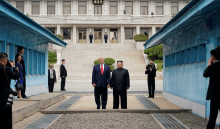kim jong un

Today, the space to negotiate peace on the peninsula remains accessible as both Koreas and the United States are not only aiming for peace and denuclearization, but on genuine economic cooperation.

TWO-THIRDS OF A CENTURY after the Korean War, most Americans do not know what happened in that conflict or how it impacts the Korean Peninsula even today.
In 1950, North Korea invaded South Korea. The U.N. intervened, and in the three years that followed the U.S. Air Force dropped more tonnage of bombs on North Korea than were used in the entire Pacific theater during World War II, including more than 30,000 tons of napalm. The U.S. destroyed 80 percent of the North’s infrastructure and 50 percent of its cities. The capital city of Pyongyang was wiped off the map.
“Over a period of three years or so, we killed off—what—20 percent of the population,” said Air Force Gen. Curtis LeMay, head of the Strategic Air Command during the Korean War. Historians believe that between 70 and 80 percent of the deaths were civilians.
Nearly 40,000 U.S. soldiers died and more than 100,000 were wounded in what has been a “forgotten war” in the United States. North Koreans, however, have never forgotten the war that resulted in millions of casualties in their country. For 65 years, they have lived under that war’s vivid memory and evolved into one of the most militarized states in the world.
The root causes of the problem
Technically, the Korean War never ended. The armistice treaty signed in 1953 reinstated the government of South Korea, suspended open hostilities, created the Demilitarized Zone, and allowed for the release of prisoners of war, but it was not a permanent peace treaty between nations. No peace treaty has ever been signed. “We have won an armistice on a single battleground—not peace in the world. We may not now relax our guard nor cease our quest,” said President Dwight Eisenhower.

Moon greeted Kim at the military demarcation line where the men smiled and shook hands. In an unplanned move, Kim invited Moon to step briefly across into North Korea, before the two leaders crossed back into South Korea holding hands.

Lawmakers from North and South Korea are reported to be negotiating the details of a joint statement that could outline an end to the 1950-1953 Korean conflict that ended in a truce, not a peace treaty.

Today, March 19, 2013, is the 10th anniversary of the “Shock and Awe” campaign that was intended to rid the world of the threat of Saddam Hussein’s weapons of mass destruction in Iraq. As it turned out, the threat was a lie. There was ample evidence at the time to prove that the WMDs didn’t really exist, but were manufactured in Saddam’s imagination for political gain.
So why did we fall so easily for this lie? Answers to this question often come via an analysis of the particulars of the Iraqi situation and include discourse about oil fields, geopolitical calculations, even psychological analysis of the relationship of Father and Son Bush. These are good discussions to have. We can learn a great deal from them about our thirst for security and insatiable appetite for oil, political power, and revenge.